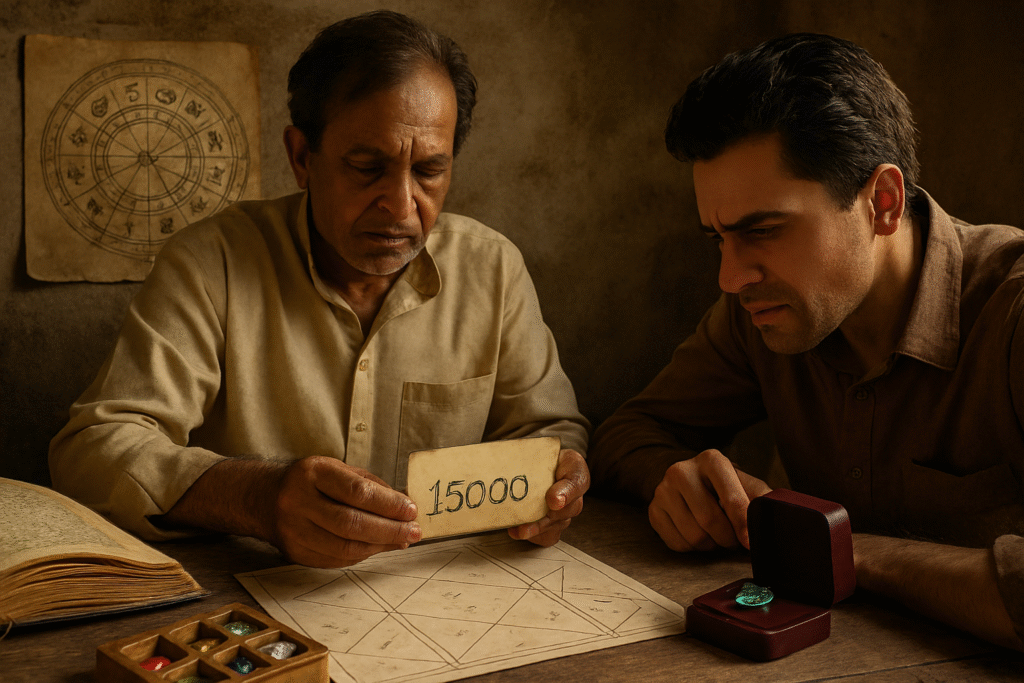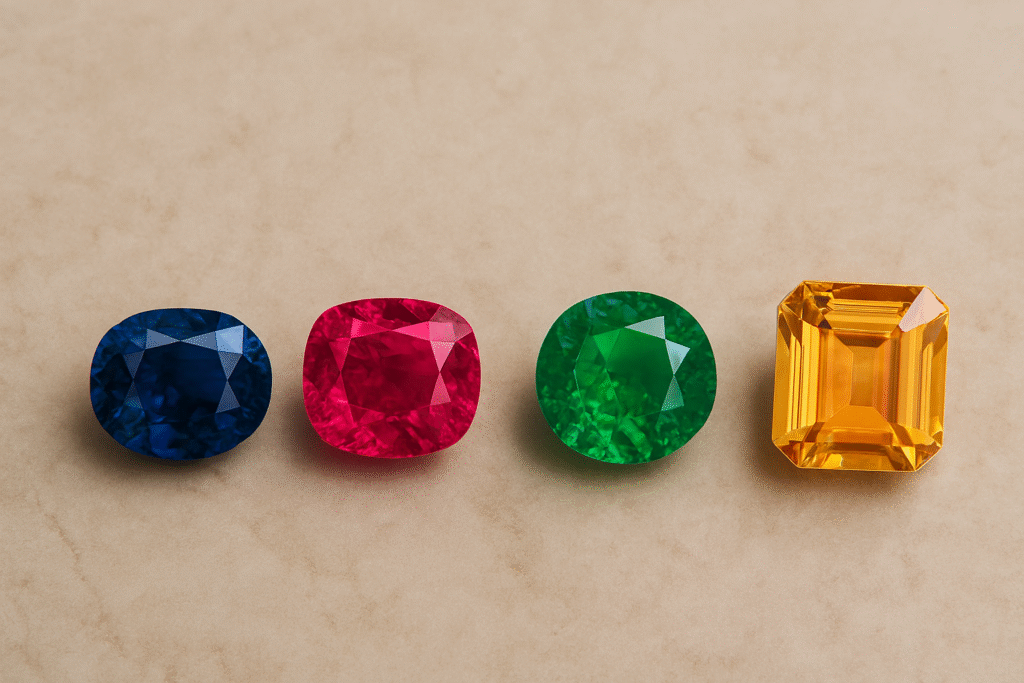When shopping for gems and jewelry, you need to follow practical rules that protect your money and guarantee quality.
- Always buy from a trusted jeweler
- Always ask for a detailed receipt
A reliable jeweler gives you authenticity and accountability. A proper receipt documents purity, gemstone type, and any warranty.
How to Inspect Jewelry Before Buying
Use a 10x magnifying lens. Check:
- Settings: Are the stones held firmly?
- Metal markings: Look for purity marks such as 22K, 18K, 925 (silver), or Pt950 (platinum).
- Maker’s mark: A traceable hallmark adds credibility.
- Stones: Examine for chips, cracks, or flaws that affect beauty and durability.
💡 The key is simple: You rarely find bargains in the gem world. Quality comes at a fair price.
Why Low Prices Can Be Risky
Cheaper jewelry may signal:
- Lower quality materials
- Incorrect labeling (e.g., citrine sold as topaz, or green glass sold as jade)
- Misleading trade names
Research shows that over 60% of jewelry complaints involve misrepresentation of gems.
Understanding Gemstone Value
The value of a gemstone depends on:
1. Color
- Strong, natural colors fetch higher prices.
- Lighting affects how you see color. Always check under natural light.
2. Clarity
- Diamonds, topaz, aquamarine, and tanzanite are judged strictly on inclusions.
- Emeralds and red tourmalines almost always show inclusions, so grading is more lenient.
3. Cut
- Proportions and finish affect sparkle and durability.
- Poorly cut stones may break more easily.
- A high-quality cut improves brilliance by up to 30% compared to average cuts.
4. Carat Weight
- Larger gems cost more per carat because they’re rarer.
- Stones above 40 carats may drop in value if they become impractical for jewelry use.
Case Example: Emeralds
An emerald with vivid green color but visible inclusions can cost more than a flawless light-colored stone. The market pays for intensity of color, not just clarity.
FAQ: Shopping for Gems and Jewelry
Q: What documents should I ask for when buying jewelry?
A: Always request a bill with details on purity, stone weight, and certification.
Q: Are bargains in gemstones real?
A: Rarely. A low price often means poor quality or misrepresentation.
Q: Which factor affects gemstone price the most?
A: Color. For example, a fine blue sapphire can be 50% more expensive than a similar but paler stone.
Q: How do I avoid buying fake jade?
A: Ask for a gemological certificate and avoid vague labels like “jade-like stone.”
Quotable Insights
- “You rarely find true bargains in the gem market. Value is tied to quality and trust.”
- “Color is the single biggest driver of a gemstone’s price.”
- “A skilled cut can increase brilliance by 30% or more.”
This comprehensive global cuisine FAQ covers everything about Asian and Western food and drinks. Whether you’re exploring international cooking techniques or discovering new flavors, this global cuisine FAQ answers the most frequently asked questions about world food traditions, ingredients, and culinary practices from both Eastern and Western cultures.
Global Cuisine FAQ: Asian & Western Food & Drinks
Food reveals cultural contrasts in clear and delicious ways. From cooking methods to dining customs, Asian and Western cuisines showcase unique traditions while also offering fascinating overlaps. Below, you’ll find answers to the most common questions about these culinary worlds.
Understanding Core Differences in Cuisine
1. What distinguishes Asian and Western culinary traditions?
Asian meals often rely on rice or noodles as a foundation. Flavors usually come from soy sauce, ginger, garlic, and a wide variety of spices. Meanwhile, Western gastronomy emphasizes bread, potatoes, and pasta. Dairy plays a key role, with butter, cream, and cheese giving richness to many dishes. Herbs such as rosemary and thyme highlight European cooking. These contrasts create distinct dining habits and flavor profiles.
2. Are Asian dishes always spicy?
No, not at all. While cuisines from Thailand and parts of India feature bold use of chilies, not every dish follows this pattern. Japanese sushi, Chinese dim sum, and Korean bulgogi are mild examples. In fact, Asian cuisines range from fiery to delicate, showcasing a rich palette of flavor.
Western Breakfast Staples and Comfort Foods
1. What constitutes typical Western morning meals?
Western breakfasts often include eggs, bacon, and toast. Pancakes, waffles, and cereal are also popular choices. These hearty starts are usually enjoyed with coffee, tea, or juice, providing both energy and comfort.
2. What represents popular Western comfort foods?
Comfort foods in the West speak to nostalgia and indulgence. Creamy macaroni and cheese, pizza, and hearty casseroles are favorites. Similarly, burgers and fried chicken have wide appeal. Because they are warm, filling, and familiar, these dishes strongly connect to emotion.
Cultural Dining Practices
1. Do all Asian cultures employ chopsticks?
No. Chopsticks dominate in East Asia—China, Japan, and Korea. However, Southeast Asia prefers spoons and forks, while India and parts of the Middle East often use flatbreads or hands. This diversity highlights how food customs closely reflect culture.
2. Why are some Asian foods fermented?
Fermentation preserves food while also enhancing nutrition and flavor. Korean kimchi, Japanese miso, and Indonesian tempeh show how tradition meets health benefits. These foods are valued not only for taste but also for their role in well-being.
Common Western Beverages
1. What beverages are common with Western meals?
Western dining often features water, soda, or fresh juice. Alcohol also has a strong cultural connection, with wine served at European dinners and beer central in North America. In the southern United States, sweet iced tea is a staple.
Dietary Flexibility and Options
1. Can one discover plant-based options easily?
Yes. Asian cuisines offer tofu stir-fries, lentil dals, and vegetable curries that are naturally vegetarian. Western food, similarly, embraces plant-based eating. Salads, vegetarian pastas, and vegan burgers have grown popular, making meat-free dining accessible worldwide.
Unique Asian Drinks to Explore
1. What are some unique Asian beverages?
Asia provides a wide variety of distinctive drinks. Bubble tea, from Taiwan, combines tea with chewy tapioca pearls. Japanese sake, made from rice, holds deep cultural meaning. Strong Vietnamese iced coffee, sweetened with condensed milk, adds a bold twist compared to Western brews.
Portion Sizes and Dining Habits
1. How do portion sizes compare?
Western meals often emphasize large servings, reflecting abundance. By contrast, Asian meals are usually smaller yet balanced, encouraging sharing and mindful eating. This creates different social experiences around the table.
The Art of Fusion Cuisine
1. Is it feasible to integrate Asian and Western flavors?
Absolutely. Fusion cuisine blends traditions in creative ways. For instance, teriyaki burgers combine Japanese flavors with American fast food, while kimchi tacos bring Korean spice to Mexican street food. These playful mixes show how food bridges cultures.



